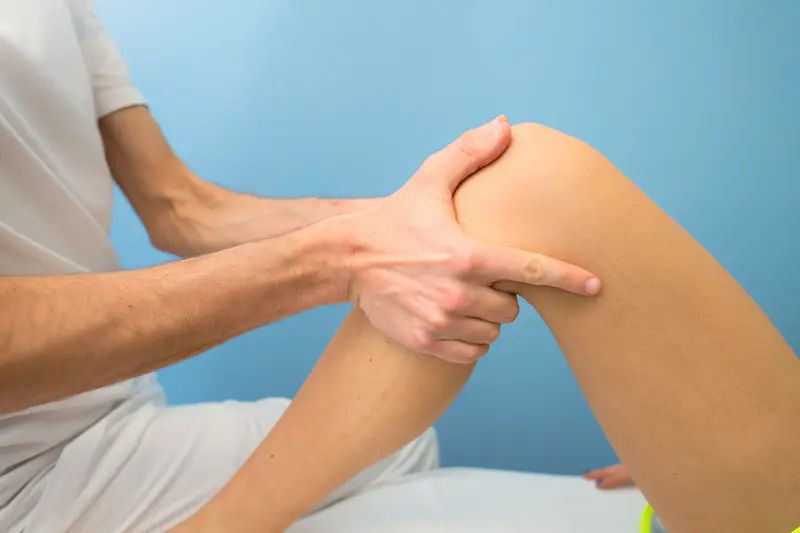Thigh Pain: Overview and Management
Understand the causes of thigh pain, from muscle strain to nerve issues. Learn about symptoms, diagnosis, and effective management strategies for pain relief and improved mobility.


Introduction
Thigh pain is a common issue that can affect people of all ages. Whether it’s a dull ache, sharp pain, or persistent discomfort, thigh pain can interfere with daily activities and reduce quality of life. Understanding the causes, symptoms, and management strategies can help you take the right steps toward relief.
What Causes Thigh Pain?
Thigh pain can stem from various factors, including injuries, muscle strains, nerve issues, or underlying medical conditions. Some common causes include:
1. Muscle Strain or Overuse: Heavy exercise, sudden movements, or prolonged physical activity can strain thigh muscles (quadriceps or hamstrings), leading to pain.
2. Nerve Compression: Conditions like sciatica (compression of the sciatic nerve) or meralgia paresthetica (compression of the lateral femoral cutaneous nerve) can cause thigh pain, numbness, or tingling.
3. Injuries: Falls, sports injuries, or accidents can lead to fractures, deep bruises (contusions), or ligament tears.
4. Arthritis: Osteoarthritis or rheumatoid arthritis affecting the hip or knee joints may radiate pain to the thigh.
5. Deep Vein Thrombosis (DVT): A blood clot in the leg veins can cause swelling, warmth, and severe pain in the thigh.
6. Peripheral Artery Disease (PAD): Poor blood circulation due to narrowed arteries can lead to cramping and pain, especially while walking.
7. Infections or Inflammation: Conditions like cellulitis (skin infection) or myositis (muscle inflammation) may cause thigh pain.
Symptoms Associated with Thigh Pain
Depending on the cause, thigh pain may present with:
Muscle soreness or stiffness
Sharp or shooting pain
Swelling or bruising
Numbness or tingling
Weakness in the leg
Difficulty walking or standing
If you experience severe pain, sudden swelling, fever, or inability to move your leg, seek medical attention immediately, as these could indicate a serious condition like DVT or a fracture.
How to Manage Thigh Pain at Home?
For mild to moderate thigh pain, these self-care tips may help:
1. Rest and Avoid Strain
Take a break from activities that worsen the pain.
Avoid heavy lifting or excessive walking until the pain subsides.
2. Apply Ice or Heat
Ice packs (for the first 48 hours after injury) help reduce swelling.
Warm compresses (after 48 hours) can relax stiff muscles.
Consult Top Specialists for Personalised Tips
3. Gentle Stretching and Exercise
Light stretches for the hamstrings and quadriceps can improve flexibility.
Low-impact exercises like swimming or cycling may help strengthen muscles without strain.
4. Over-the-Counter Pain Relief
Medications like ibuprofen or acetaminophen can ease pain and inflammation (consult a doctor before long-term use).
5. Compression and Elevation
Wear a compression bandage to reduce swelling.
Elevate your leg while resting to improve blood flow.
When to See a Doctor?
While many cases of thigh pain resolve with home care, consult a doctor if:
Pain persists for more than a week.
There is severe swelling, redness, or warmth in the thigh.
You experience sudden numbness or weakness.
You suspect a fracture or blood clot.
Diagnosis and Treatment
A doctor may recommend:
Physical examination to assess muscle strength and range of motion.
Imaging tests (X-ray, MRI, or ultrasound) to check for fractures, muscle tears, or nerve issues.
Blood tests if an infection or clotting disorder is suspected.
Treatment depends on the cause:
Physical therapy for muscle or joint-related pain.
Medications (pain relievers, muscle relaxants, or blood thinners for DVT).
Surgery (rarely needed, except for severe fractures or nerve compression).
Preventing Thigh Pain
To reduce the risk of thigh pain:
Warm up before exercise and stretch regularly.
Stay hydrated to prevent muscle cramps.
Maintain a healthy weight to reduce joint stress.
Wear supportive footwear to avoid strain.
Avoid prolonged sitting or standing—take breaks to move around.
Need Expert Advice?
If thigh pain is affecting your daily life, don’t ignore it. Early diagnosis and treatment can prevent complications. You can book a consultation with an orthopaedic specialist or physiotherapist through Apollo 24|7 for personalised care.
Thigh pain doesn’t have to slow you down—understanding the cause and taking the right steps can help you recover faster and stay active.
Consult Top orthopedics
Consult Top Specialists for Personalised Tips
Dr. Anil Sharma
Orthopaedician
42 Years • MBBS, MS Orthopedics
New Delhi
AAKASH MEDSQUARE, New Delhi

Dr. Anil Pradeep Jadhav
Orthopaedician
23 Years • MBBS MS (Ortho)
Nashik
Apollo Hospitals Nashik, Nashik
(25+ Patients)

Dr. Manoj Dinkar
Orthopaedician
15 Years • MBBS, Dip (Orthopaedics)
New Delhi
THE DOCTORS NESST, New Delhi

Dr. Mriganka Ghosh
Orthopaedician
11 Years • MD (Physician), DNB (Orthopaedics)
Howrah
Dr Mriganka Mouli Ghosh, Howrah

Dr. Pradeep Lucas
Orthopaedician
7 Years • MBBS, Diploma in Orthopaedics, Fellowship in DFSI
Bengaluru
Revival Multispeciality Clinic, Bengaluru
Consult Top orthopedics
Dr. Anil Sharma
Orthopaedician
42 Years • MBBS, MS Orthopedics
New Delhi
AAKASH MEDSQUARE, New Delhi

Dr. Anil Pradeep Jadhav
Orthopaedician
23 Years • MBBS MS (Ortho)
Nashik
Apollo Hospitals Nashik, Nashik
(25+ Patients)

Dr. Manoj Dinkar
Orthopaedician
15 Years • MBBS, Dip (Orthopaedics)
New Delhi
THE DOCTORS NESST, New Delhi

Dr. Mriganka Ghosh
Orthopaedician
11 Years • MD (Physician), DNB (Orthopaedics)
Howrah
Dr Mriganka Mouli Ghosh, Howrah

Dr. Pradeep Lucas
Orthopaedician
7 Years • MBBS, Diploma in Orthopaedics, Fellowship in DFSI
Bengaluru
Revival Multispeciality Clinic, Bengaluru




